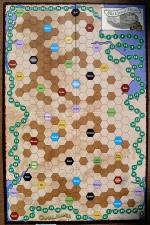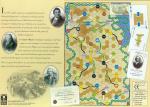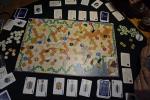Produktbeschreibung
We have designed a boardgame about the great Canal building era of the eighteenth and nineteenth centuries that captures the feel of the period and gives players plenty of decision making in their attempts to complete some of the most famous British canals. Players will engage brilliant engineers such as James Brindley and Thomas Telford in their efforts to create canals linking emerging manufacturing centres, providing the waterways that supplied the goods generated by the Industrial Revolution.
The initial inspiration for the game came during a visit to Llangollen in Wales and a walk along the Chirk aqueduct and through it's adjoining tunnel. Right beside the aqueduct is a railway viaduct, which was purposely built taller than its rival transport and sported rather vulgar statues of the railway owners. Having played numerous railway games, it occurred to me that canals have been very much overlooked yet might afford opportunity for a simple, elegant game. Visiting various bookshops revealed that railway books grossly outnumbered anything on canals, furthering the Ragnar instinct to champion the under-dog - if not the obscure!
It took some eighteen months to bring the game to publication and the process involved one notable design re-start. Once the general framework was established there was a period of intense game testing and some hard-edged designing, Dicken manfully play testing and commenting for weeks on end. As with "Viking Fury" the final hammering out of ideas and rules involved a great deal of daily correspondence between the Kendall brothers via e-mail and the telephone. It lasted some three weeks, but our wives will probably challenge this!
Here are some of the key points in the designing of the game.
- It was always the intention to give the game an historic under-pinning in much the same way that earlier Ragnar Brothers games have tried; for example, "Angola", "History of the World" and "Kings and Castles". This meant sticking with the canals that were actually built, rather than allowing a more flexible system. It has not been possible to accommodate all the canals built during the period.
- Some of the contracts refer to "navigations" rather than canals. These involved work on rivers and dykes to make them more navigable as opposed to a canal, which was basically a new waterway.
- Though the time period for the game is less than seventy years, it is considerably longer than the working life of any of the engineers. Engineers did work for different employers hence the opportunity to exchange them within the game. There is some correlation, albeit fairly limited, between the engineer's special advantage and the historic person. For example, Telford was renowned for his wonderful aqueducts.
- Some limited modifications to canal routes have had to be introduced in order to prevent congestion (for example, the Bridgewater canal and Llangollen canal). The ManchesterShip canal did feature in the game for quite some time, but was removed as the Bridgewater and Macclesfield canals adequately covered its route. The Rochdale canal has been included with the connecting navigations on the Eastern side of the Pennines. The Grand Union canal is named thus as it will be more familiar than its original name of Grand Junction. It has been subdivided into three parts, being much the same way as it was constructed.
- The term "city" should not be taken literally. Many of the towns featured would have been cities in reality. However, the term is used to emphasise the strategic importance of the six cities within the game and in the 18th Century reality.
- Adjustments have had to be made regarding some towns. For example, Rochdale did appear in earlier drafts of the game, but was removed as a result of its proximity to Manchester.
- The colour coding of towns has been used as a tool to prevent unusual, high-scoring routes. For example, Bristol and Gloucester appear as the same colour to prevent lengthy and lucrative goods moves between the two when in reality goods would have travelled between the two on the river Severn or via the Sharpness canal (not featured in the game).
- It is perhaps the architecture of canals that is most striking today, so this was always a point of emphasis in the design. Tunnels took the longest time to build, followed by aqueducts. Cuttings and embankments are other ways by which engineers were able to drive canals through difficult terrain and these are included within the catch-all of "tunnel" and "aqueduct" respectively.
- Canals were often built in sections, connecting up as they lengthened towards each other. Sometimes work began at both termini simultaneously. Allowing players to choose which termini to start building from is a simplification of such construction decisions.
- Various entrepreneurs and companies built canals. They sometimes took similar routes to the canals of rivals and, though "crossing" a canal would present little engineering difficulty, there were often political problems to overcome involving time and money.
- The more frenetic activity of the final rounds is designed to give a sense of climax and shape to the game. It also bears some resemblance to the end of the great age of canal building, when companies began to be squeezed and trade diminished in the face of the emerging muscularity of the railways.
- Canal Mania 1st. edition is not a two-player game. It could be played with two players, but from the outset the game was intended to draw from its theme, to foster character and humour, and to give folks chance to enjoy some social gaming. |




